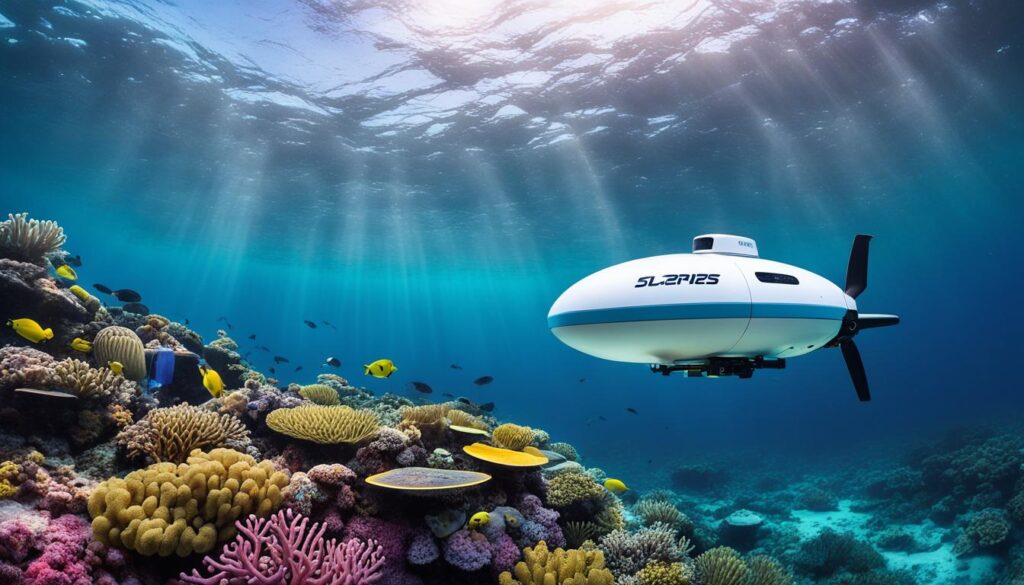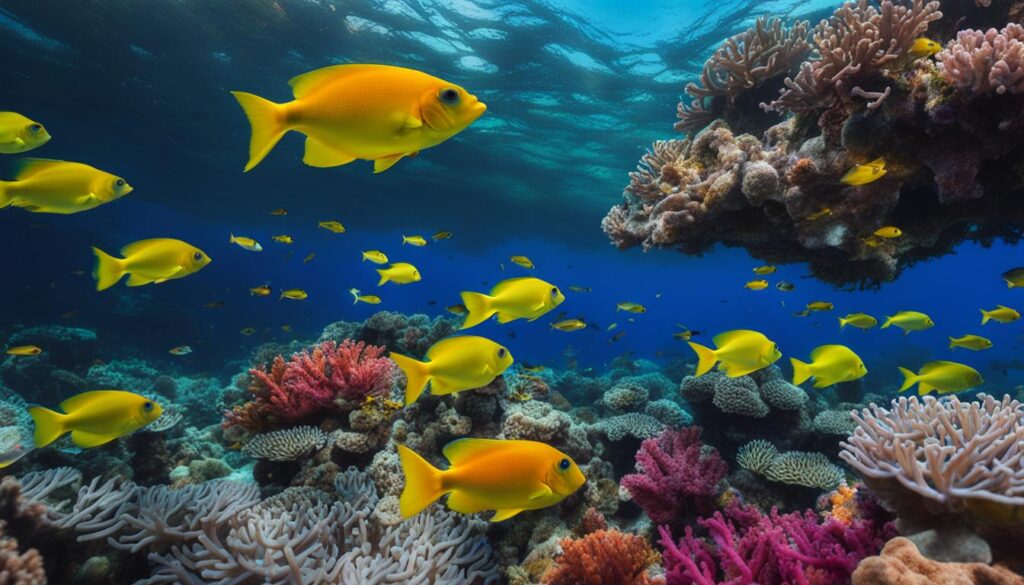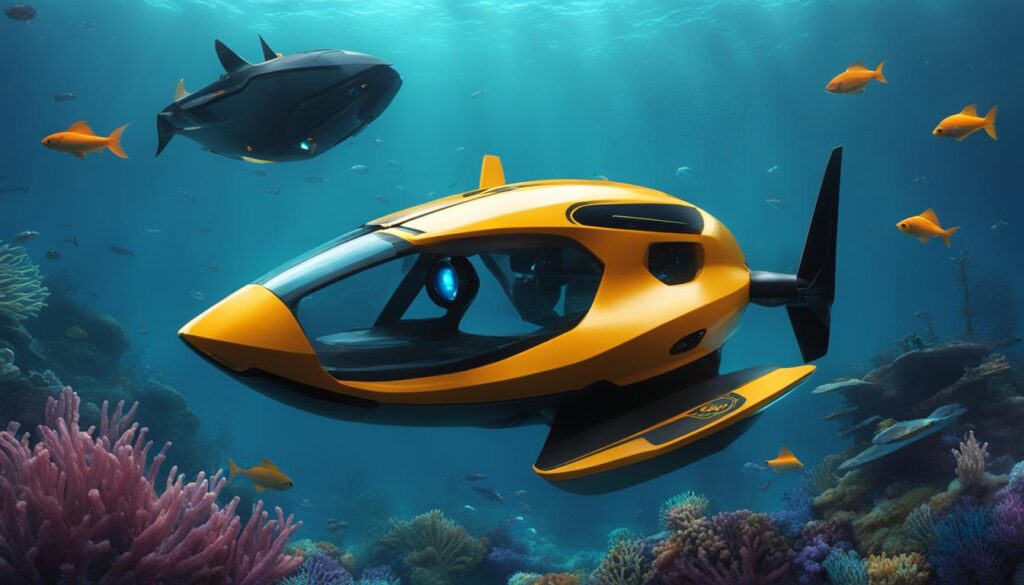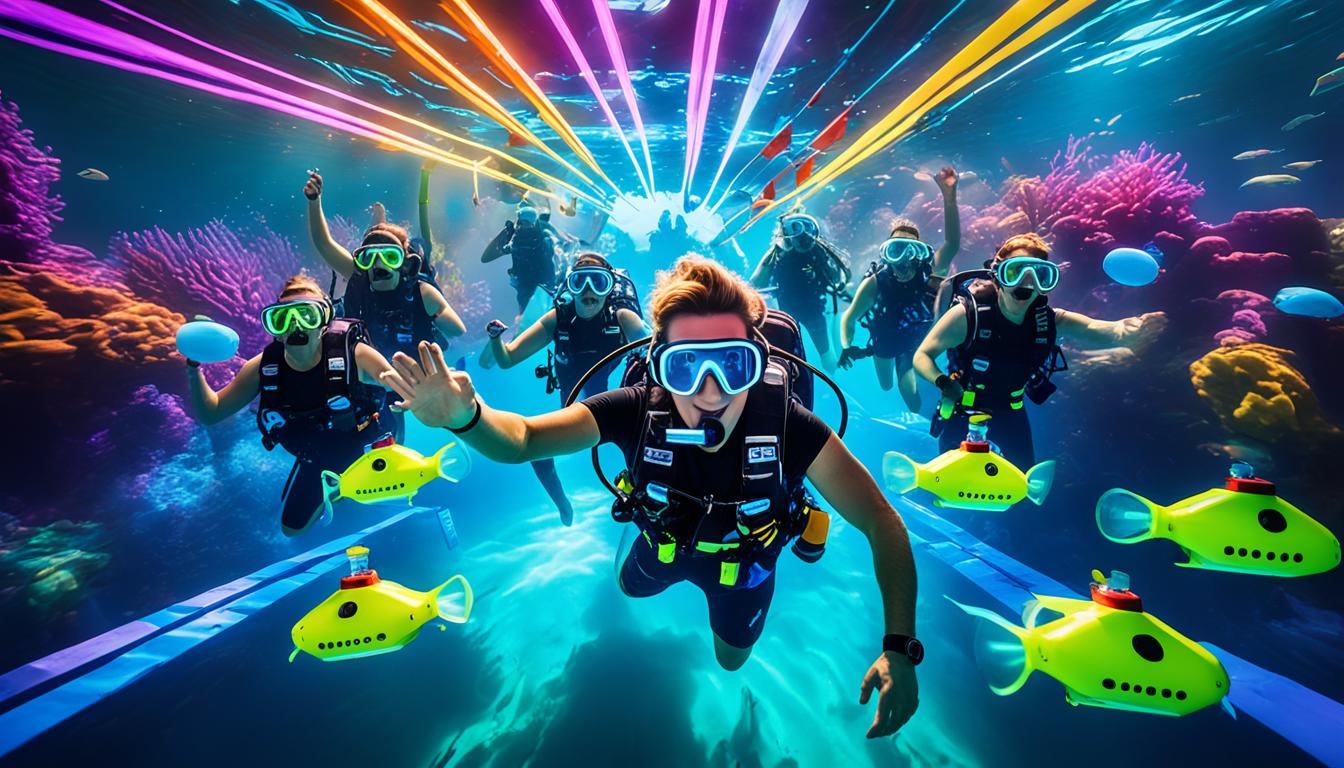Welcome to the fascinating world of underwater drones, where cutting-edge technology meets the mysteries of the deep sea. These remarkable devices have revolutionized underwater exploration and marine research, allowing us to dive deeper and uncover the secrets hidden beneath the ocean’s surface.
With their advanced capabilities, underwater drones provide us with a window into a realm that was once inaccessible to us. They allow scientists, researchers, and explorers to navigate the depths with ease, collecting valuable data and capturing breathtaking visuals in the process.
Through the use of underwater drones, we are able to explore underwater ecosystems, study marine life, and investigate underwater structures and geological formations. By delving into the depths, we can gain a better understanding of the vast and mysterious oceans that cover our planet.
Join us on a journey of discovery as we dive deep into the world of underwater drones and uncover the wonders they have revealed. From mapping uncharted territories to making groundbreaking discoveries, these drones have opened up new opportunities for marine research and exploration.

Key Takeaways:
- Underwater drones have revolutionized underwater exploration and marine research.
- These devices allow scientists to navigate the depths, collecting valuable data and capturing visuals.
- Underwater drones enable us to study marine life, investigate structures, and explore underwater ecosystems.
- They have opened up new opportunities for mapping uncharted territories and making groundbreaking discoveries.
- The use of underwater drones has greatly contributed to our understanding of the vast and mysterious oceans.
The Evolution of Underwater Technology
Welcome to the fascinating world of underwater technology, where innovation has led to the development of unmanned underwater vehicles (UUVs) that are revolutionizing marine exploration. Over the years, advancements in marine technology have paved the way for the creation of sophisticated underwater drones capable of delving into the depths of the ocean.
Throughout history, humans have been drawn to the mysteries of the underwater world. From the early days of diving bells to the invention of remotely operated vehicles (ROVs), the evolution of underwater technology has been driven by the desire to explore and understand our oceans.
Unmanned underwater vehicles, also known as underwater drones, are autonomous or remote-controlled devices equipped with sensors and cameras that allow scientists and researchers to navigate and capture valuable data in the underwater environment. These technological marvels have become indispensable tools in marine research, enabling us to explore and document the hidden wonders of the deep.
Underwater drones have revolutionized underwater exploration by providing unprecedented access to areas that are difficult or dangerous for human divers to reach. With their advanced maneuverability, underwater drones are able to navigate the complex terrain of underwater caves, deep-sea trenches, and remote underwater regions, capturing high-resolution images and videos to be analyzed and studied later.
Underwater drones are a testament to the remarkable progress made in marine technology. They have become invaluable assets in marine research, opening up new possibilities and unlocking the secrets of the ocean’s depths.
Today’s underwater drones are equipped with state-of-the-art technology, including advanced sonar systems, high-definition cameras, and precision navigation capabilities. These features enable researchers to map the ocean floor, study marine life, monitor environmental changes, and even search for underwater archaeological artifacts.
They have proven instrumental in a wide range of applications, including ecological studies, ocean floor mapping, offshore infrastructure inspection, and search and rescue missions. With their ability to operate for extended periods of time and travel to great depths, underwater drones are bringing us closer to understanding the complex ecosystems and geological formations that exist beneath the waves.
The Advancements in Unmanned Underwater Vehicles
The evolution of underwater technology can be traced back to the mid-20th century, with the development of early ROVs that were primarily used in military operations and offshore industries. These early vehicles laid the foundation for further advancements in the field.
As technology improved and miniaturization became possible, UUVs became more compact, maneuverable, and cost-effective. Today, UUVs come in various shapes and sizes, designed to fulfill specific research objectives and exploration needs.
Advancements in communication technologies have also played a significant role in the development of underwater drones. With the advent of satellite communication and wireless connectivity, researchers can now control and monitor underwater drones in real-time, allowing for more efficient and effective data collection.
As marine technology continues to advance, the potential for underwater exploration and research expands. With ongoing developments in autonomy, artificial intelligence, and sensor technology, the future of underwater drones looks promising, offering endless possibilities for uncovering the secrets of the deep sea.
| Advancements in Underwater Technology | Impact |
|---|---|
| Miniaturization of underwater vehicles | Increased maneuverability and accessibility to hard-to-reach areas |
| Improvements in sensor technology | Enhanced data collection and analysis capabilities |
| Advancements in communication systems | Real-time monitoring and control of underwater drones |
| Integration of autonomy and artificial intelligence | Increased operational efficiency and autonomous decision-making |
Unleashing the Power of Underwater Robotics
Underwater robotics has opened up a whole new realm of possibilities for deep-sea exploration. These cutting-edge technologies, such as deep-sea drones, are revolutionizing marine research and unlocking the mysteries of the ocean.
Equipped with advanced navigation systems and state-of-the-art sensors, deep-sea drones are designed to withstand the extreme conditions of the deep sea. These robotic devices can submerge to considerable depths, collecting valuable data and capturing high-resolution images of underwater environments.
One of the remarkable features of underwater robotics is their ability to provide scientists and researchers with real-time data. This immediate access to information enables rapid decision-making and facilitates a deeper understanding of the complex marine ecosystems.
Underwater robotics allows us to explore parts of the ocean that were previously inaccessible. These technologies are transforming marine research and helping us unravel the secrets of the deep sea.
The autonomous nature of deep-sea drones also allows for extended missions without human intervention. These robots can stay submerged for long periods, collecting continuous data on water temperature, salinity, and underwater currents. By analyzing this data, scientists can gain insights into the dynamic nature of the ocean and its impact on marine life.
Furthermore, underwater robotics plays a crucial role in monitoring and studying fragile ecosystems, including coral reefs and deep-sea vents. By capturing detailed images and videos, these robotic devices aid in the documentation and conservation of these unique habitats.
Advancing Marine Research with Underwater Robotics
The integration of underwater robotics in marine research has allowed scientists to explore areas that were once beyond our reach. With the help of deep-sea drones, researchers can investigate uncharted territories, discover new species, and uncover hidden geological formations.
The data collected by these robotic devices provides valuable insights into the impact of climate change and human activities on marine ecosystems. By monitoring water quality, biodiversity, and environmental factors, researchers can develop effective conservation strategies and make informed decisions for the sustainable management of our oceans.
The capabilities of underwater robotics extend beyond scientific research. These technologies have also found applications in underwater infrastructure inspection, offshore oil and gas exploration, as well as search and rescue operations.
In conclusion, underwater robotics has revolutionized the field of deep-sea exploration. With their advanced capabilities and autonomous operation, deep-sea drones are helping scientists and researchers uncover the secrets of the ocean, paving the way for a better understanding of marine ecosystems and the conservation of our precious underwater resources.
Mapping the Underwater Frontier
Accurate underwater mapping plays a vital role in advancing oceanic research and exploration. By creating detailed maps of the ocean floor, underwater drones equipped with advanced technology enable us to uncover hidden structures, identify topographical features, and gain valuable insights into the mysterious depths of our oceans.
The tools and techniques used by underwater drones for mapping are innovative and sophisticated. These underwater exploration tools utilize state-of-the-art sonar systems, multibeam echo sounders, and high-resolution imaging sensors to capture precise data about the underwater terrain. The data collected is then processed and transformed into detailed underwater maps that provide scientists and researchers with a comprehensive understanding of the marine environment.
The Power of Underwater Mapping
Underwater mapping serves as a foundation for various areas of oceanic research. It allows scientists to identify and study underwater ecosystems, monitor environmental changes, and locate potential sites of marine biodiversity or geological phenomena. Additionally, it aids in the planning and execution of marine expeditions, facilitating safer navigation and enhancing the efficiency of underwater exploration.
The information obtained through underwater mapping helps scientists explore and protect delicate marine ecosystems by providing essential data for conservation efforts. These maps enable marine biologists to identify and study coral reefs, underwater habitats, and other critical ecological zones. By understanding these ecosystems, researchers can develop effective strategies for the preservation and sustainable management of our ocean resources.
“Underwater mapping is an essential tool for understanding the complex and interconnected systems that make up our oceans. It empowers scientists to explore and protect marine environments, unlocking the secrets hidden beneath the surface.”
Furthermore, accurate underwater mapping supports the discovery and exploration of underwater archaeological sites. These maps can reveal submerged ancient civilizations, shipwrecks, and artifacts, shedding light on our historical and cultural heritage.
| Benefits of Underwater Mapping | Applications |
|---|---|
| Understanding marine ecosystems | Evaluating the impact of climate change on underwater habitats |
| Mapping underwater geological formations | Locating potential sites for offshore energy production |
| Planning marine conservation efforts | Preserving underwater cultural heritage |
Accurate and detailed underwater mapping is a crucial component of modern oceanic research, enabling us to explore and understand the complex world beneath the waves. By harnessing the power of underwater exploration tools, we continue to unveil the mysteries that lie within our oceans, making remarkable discoveries and advancing our knowledge of the underwater frontier.
Revealing the Depths: Ocean Discoveries
Thanks to the advancements in deep-sea exploration and the use of underwater drones, our understanding of the ocean has vastly expanded. These remarkable devices have allowed us to unveil a myriad of fascinating discoveries beneath the waves. From new species to ancient artifacts, let’s explore some of the incredible ocean discoveries made possible by underwater drones.
The Unseen Realm of Marine Life

One of the most exciting aspects of deep-sea exploration is the opportunity to discover previously unknown species. Underwater drones equipped with high-definition cameras and sensors have captured stunning footage of unique marine life forms thriving in the depths of the ocean. These discoveries have not only thrilled marine biologists but have also shed light on the fragile ecosystems that exist in the underwater realm.
The deep sea is full of surprises. Our underwater drones have revealed species never before seen by human eyes. From bioluminescent creatures to bizarrely shaped organisms, each expedition holds the potential for remarkable discoveries.
Unlocking the Secrets of the Past
The ocean has long been a repository of history, holding untold stories of human civilization and natural events. Underwater drones equipped with state-of-the-art sonar systems have assisted in uncovering ancient shipwrecks and historical artifacts that date back centuries. These remarkable findings provide valuable insights into our past and offer a glimpse into the lives of those who came before us.
A Glimpse into Earth’s Geological History
Beneath the vast expanses of the ocean lies a treasure trove of geological wonders. Underwater drones have mapped and explored underwater volcanoes, deep-sea trenches, and other unique landforms hidden from human view. These discoveries contribute to our understanding of Earth’s geological processes and provide insights into the history of our planet.
| Discovery | Description |
|---|---|
| Ancient Shipwrecks | A collection of shipwrecks discovered by underwater drones, revealing historical artifacts and providing insights into maritime trade routes. |
| New Species | A variety of previously unknown marine species captured on camera during deep-sea exploration missions. |
| Underwater Volcanoes | Exploration of underwater volcanic structures, shedding light on Earth’s geothermal activity and its impact on the ocean ecosystem. |
These ocean discoveries are a testament to the power of deep-sea exploration and the invaluable role of underwater drones. As we continue to uncover the secrets of the underwater world, our knowledge and appreciation for the vast and awe-inspiring ocean environment will only grow.
Unraveling Secrets: The Science of Marine Research
Marine research plays a pivotal role in deepening our understanding of marine life, ecosystems, and environmental changes. As scientists strive to unravel the secrets hidden beneath the ocean’s surface, innovative technologies such as underwater drones have become invaluable tools in gathering critical data and conducting groundbreaking studies.
Underwater drones equipped with state-of-the-art sensors and imaging systems enable researchers to explore the vast underwater world with unprecedented precision and efficiency. These advanced marine technologies provide scientists with a unique perspective, allowing them to observe marine organisms in their natural habitats and capture high-resolution data in real-time.
The application of underwater drones in marine research has revolutionized the way scientists study marine ecosystems. By remotely operating these unmanned vehicles, researchers can venture into inaccessible and hazardous environments, collecting valuable data without disturbing the delicate balance of marine ecosystems.
“Underwater drones have opened up new horizons in marine research. Their ability to navigate the depths of the ocean and gather precise data has allowed us to study marine organisms and ecosystems in ways never before possible.” – Dr. Jane Fernandez, Marine Biologist
Marine research projects rely on underwater drones to investigate a wide range of topics, from biodiversity and species distribution to the impacts of climate change on marine ecosystems. By analyzing data collected by these autonomous devices, scientists can better understand the interconnectedness of marine life and gain insights into the intricate processes that govern our oceans.
Whether it’s tracking the migration patterns of marine mammals, monitoring the health of coral reefs, or studying the effects of pollution on marine biodiversity, underwater drones provide scientists with a wealth of information that contributes to the preservation and sustainable management of our marine resources.
Advantages of Underwater Drones in Marine Research
- Efficient data collection: Underwater drones can cover large areas of the ocean quickly, collecting vast amounts of data in a short period.
- Precision and accuracy: Equipped with sophisticated sensors, underwater drones can capture precise measurements and detailed imagery, ensuring reliable data analysis.
- Access to remote locations: Underwater drones allow researchers to explore remote and deep-sea regions that are difficult, if not impossible, for humans to access.
- Minimal environmental impact: Unlike traditional research methods that may disturb marine life or cause damage to delicate ecosystems, underwater drones provide a non-intrusive means of data collection.
With their capabilities and versatility, underwater drones have become indispensable tools in the field of marine research, enabling scientists to unravel the mysteries of the underwater world and contribute to the broader understanding of our planet’s oceans.
| Applications of Underwater Drones in Marine Research | Key Discoveries and Contributions |
|---|---|
| 1. Biodiversity mapping and assessment | 1. Identification of new species and ecosystems |
| 2. Studying marine migration patterns | 2. Insights into seasonal behaviors and reproductive cycles |
| 3. Monitoring and preserving coral reefs | 3. Assessment of coral resilience and recovery mechanisms |
| 4. Investigating deep-sea ecosystems | 4. Exploration of previously uncharted regions and identification of unique species |
| 5. Assessing the impacts of climate change | 5. Understanding the effects of rising temperatures on marine biodiversity |
| 6. Environmental monitoring and pollution assessment | 6. Study of pollutant levels and their effects on marine ecosystems |
Challenges and Limitations: Navigating the Deep
Despite the advancements in underwater technology and the remarkable capabilities of underwater robotics, deep-sea exploration poses unique challenges and limitations. The extreme conditions of the deep sea, including immense pressure, darkness, and unpredictable currents, make it a harsh and inhospitable environment for underwater drones.
One of the key technical challenges faced by underwater drones is designing robust systems that can withstand the immense pressure at extreme depths. The pressure in the deep sea can reach up to 1,000 times atmospheric pressure, exerting tremendous force on the drone’s structure. Therefore, engineers and scientists are continuously developing stronger and more resilient materials to ensure the longevity and reliability of these underwater robots.
Another significant challenge is navigating and maneuvering in the darkness of the deep sea. Unlike in shallow waters, where natural light penetrates, the deep sea is shrouded in darkness. This poses a considerable obstacle for underwater drones in terms of collecting visual data and accurately mapping the underwater terrain. To tackle this, advanced imaging technologies such as sonar and high-resolution cameras with low-light capabilities have been integrated into underwater drones, enabling them to capture images and videos in the depths of the ocean.
Operational limitations also come into play during deep-sea expeditions. Unlike surface vessels or aerial drones, underwater drones have limited battery life and require frequent recharging or replacement of power sources. This limitation restricts the operational duration and range of the underwater drones, making long-duration deep-sea exploration missions challenging. As a result, researchers and engineers are continuously working on developing more efficient and long-lasting power systems to extend the endurance of underwater drones.
Despite these challenges, advancements in underwater technology and underwater robotics continue to push the boundaries of deep-sea exploration. With each obstacle overcome, our understanding of the deep sea expands, leading to groundbreaking discoveries and further advancements in marine research.

Technical Challenges in Deep-Sea Exploration
| Challenges | Solutions |
|---|---|
| Extreme pressure | Development of stronger and resilient materials |
| Darkness | Integration of advanced imaging technologies such as sonar and low-light cameras |
| Limited battery life | Research and development of more efficient and long-lasting power systems |
Pioneers in Oceanic Exploration
Throughout history, there have been visionary individuals who have pushed the boundaries of oceanic exploration, utilizing underwater drones to uncover the mysteries of the deep. Their groundbreaking research using unmanned underwater vehicles has revolutionized marine research and deep-sea exploration.
These pioneers in oceanic exploration have made significant contributions to our understanding of the oceans, revealing hidden ecosystems, uncharted territories, and fascinating marine life. By harnessing the power of underwater drones, they have brought the depths of the ocean to the forefront of scientific discovery.
One such pioneer is Dr. Sylvia Earle, a renowned marine biologist and oceanographer. Her lifelong dedication to oceanic research has led to numerous breakthroughs in marine science. Dr. Earle’s use of underwater drones has allowed her to delve into the unexplored depths of the ocean, shedding light on the importance of ocean conservation and the need to protect fragile marine ecosystems.
“The ocean is the life support system for humanity, the life support system for the planet. If we don’t take care of it, it’s our own life support system that we’re threatening.”
Another notable pioneer is Fabien Cousteau, an oceanographic explorer and environmental advocate. Continuing the legacy of his grandfather, Jacques-Yves Cousteau, Fabien has conducted extensive research using underwater drones to study and document the wonders of the ocean. Through his innovative approach, he has engaged the public in the importance of oceanic exploration and the preservation of marine environments.
These pioneers, alongside many others, have paved the way for a new era of oceanic research. Their dedication and use of underwater drones have propelled our understanding of the deep sea and the intricate web of life that exists below the surface. Through their remarkable discoveries, they have inspired future generations of scientists and explorers to continue venturing into the unknown depths.
Conclusion
Throughout this article, we have explored the fascinating world of underwater exploration and the role that underwater drones play in unlocking the secrets of our oceans. These innovative devices have revolutionized marine research, allowing scientists to delve into the depths and uncover wonders that were once hidden from us.
The discoveries made possible by underwater drones have unveiled a whole new understanding of our oceans. From mapping uncharted territories to revealing new species and ancient artifacts, these exploratory missions have expanded our knowledge and deepened our appreciation for the vast and mysterious underwater world.
As technology continues to advance, the potential for future exploration and discovery is immense. The secrets of our oceans are still waiting to be revealed, and underwater drones will be at the forefront of this ongoing quest. With their ability to navigate the deep sea and collect valuable data, these devices are paving the way for groundbreaking research and further advancements in marine technology.
FAQ
How do underwater drones work?
Underwater drones, also known as unmanned underwater vehicles (UUVs), use a combination of advanced technologies such as sonar systems, cameras, and propulsion systems to navigate and explore the underwater environment. These drones can be remotely operated or operate autonomously, collecting valuable data and transmitting it back to researchers on the surface.
What are the benefits of using underwater drones for ocean exploration?
Underwater drones have revolutionized ocean exploration by allowing researchers to access remote and inhospitable underwater locations without putting human divers at risk. These drones can map the ocean floor, study marine life, monitor underwater ecosystems, and investigate underwater phenomena, leading to significant advancements in marine research and our understanding of the oceans.
What kind of data can underwater drones collect?
Underwater drones are equipped with a wide range of sensors and instruments that enable them to collect various types of data. They can gather information on water temperature, salinity, currents, and the presence of marine life. They can also capture high-resolution images and videos, perform underwater mapping, and collect samples for further analysis.
How deep can underwater drones explore?
The depth capability of underwater drones depends on the specific model and design. Some drones are designed for shallow-water exploration, reaching depths of a few hundred meters, while others are built for deep-sea exploration and can descend to several thousand meters below the surface. Advances in underwater technology continue to push the boundaries of how deep these drones can go.
Are underwater drones used only for scientific research?
While underwater drones are primarily used for scientific research and marine exploration, their applications extend beyond academia. They are also used for commercial purposes such as underwater inspections of structures, underwater filmmaking, surveying and mapping of underwater environments, and even underwater archaeology for discovering historical artifacts.
Are there any limitations to underwater drones?
While underwater drones have significantly advanced our ability to explore the oceans, they still face certain limitations. Some challenges include limited battery life, restricted range of communication underwater, and difficulties in maneuvering in strong currents. Deep-sea exploration also poses additional challenges due to extreme pressure and harsh environmental conditions.
How can I get involved in underwater drone research?
If you are interested in underwater drone research, there are several ways to get involved. Consider pursuing a degree in marine science, ocean engineering, or robotics to gain the necessary knowledge and skills. You can also join research organizations or collaborate with existing underwater drone research projects to contribute and expand your expertise in this exciting field.






